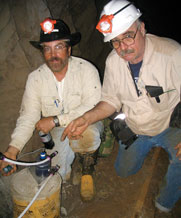 |
| hoto courtesy of James Volk |
The DUSEL cavern is getting restless
You can't feel it. Yet the moon's gravitational pull shifts the ground ever so slightly, creating “earth tides” that rhythmically raise and lower the ground.
That's enough to throw off delicate scientific equipment, such as the systems used to aim two hair's-width particle beams into a head-on collision.
And that's not the only slow, subtle movement going on. At Fermilab, for instance, the spring thaw shifts the magnets that focus particle beams. So the lab developed sensors that track ground tilt to within 1/14th the diameter of a hair over a distance of 30 feet, allowing them to correct for the motion at one-tenth the previous cost.
Now those sensors are offering a new way to cheaply monitor the effects of sucking seven megatons of water out of granite caverns that will house the world's deepest underground lab.
In January, Fermilab physicist Jim Volk (photo, right) helped Larry Stetler (left), a geological engineer from the South Dakota School of Mines & Technology, and a few graduate students install 12 of the ground sensors at the 2000-foot level of Homestake Mine, proposed future home of DUSEL.
They lugged cables, wires and water lines through puddles of muck in 75-degree heat with 95 percent humidity. More sensors will go in at the 4100-foot level this summer and at the 4850-foot level later this year.
“It was hot and dirty,” Volk says. “That brown iron ore dust, it gets in everywhere.”
After the South Dakota gold mine closed in 2001, the pumps were turned off and groundwater submerged half of its 8000-foot depth.
As that water is pumped back out, the ground shifts. Monitoring those movements, as well as earth tides and shifts in the rock triggered by excavation, will be key to calibrating research equipment.
“It is not pure high-energy physics, but it is useful science,” Volk says of his work in the mine. “We are helping those guys get data and understand what is going on with the rock.”
As a bonus, he says, he's learning a lot of geology that will come in handy for other projects. Despite the discomforts of working deep underground, “I can't wait to get back there.”
Tona Kunz
Click here to download the pdf version of this article.






